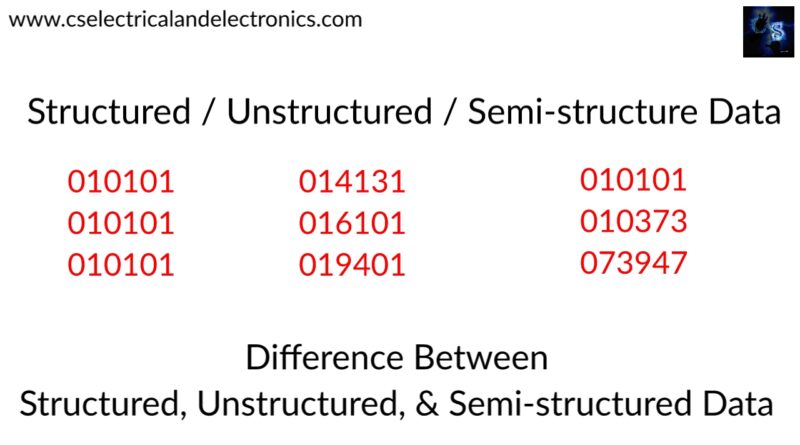Difference Between Structured, Unstructured, And Semi-structured Data
Hello guys, welcome back to my blog. In this article, I will discuss the difference between structured, unstructured, and semi-structured data, what is structured data, what is unstructured data, what is semi-structured data, etc.
If you have any doubts related to electrical, electronics, and computer science, then ask question. You can also catch me @ Instagram – Chetan Shidling.
Also, read:
- Difference Between Copper Loss And Iron Loss In Transformer.
- Difference Between 2G, 3G, 4G, 5G Technology, Benefits, Drawbacks.
- Difference Between Cascaded H-Bridge, Flying capacitors, Diode Clamped multilevel inverter.
Difference Between Structured, Unstructured, And Semi-structured Data
As demonstrated, human-generated and machine-generated data can come from a spread of sources and be represented in various formats or types. This section examines the variability of knowledge types that are processed by Big Data solutions.
The primary types of data:
- Structured data
- Unstructured data
- Semi-structured data
These data types ask for the interior organization of knowledge and are sometimes called data formats. aside from these three fundamental data types, another important sort of data in Big Data environments is metadata. Each is going to be explored successively.
Structured Data
Here the data is generated is in structured format means it is easy to find out categories of data that are generated or produced by various sources.
Structured data conform to a data model or schema and is often stored in tabular form. It is used to capture relationships between different entities and is therefore most often stored in a relational database. Structured data is frequently generated by enterprise applications and information systems like ERP and CRM systems.
Due to the abundance of tools and databases that natively support structured data, it rarely requires special consideration in regards to processing or storage. Examples of this type of data include banking transactions, invoices, and customer records.
Unstructured Data
Here the data is not generated or produced in structured format means data can be in different formats such as video, audio, image, etc.
Data that does not conform to a data model or data schema is known as unstructured data. It is estimated that unstructured data makes up 80% of the data within any given enterprise. Unstructured data has a faster growth rate than structured data.
This form of data is either textual or binary and often conveyed via files that are self-contained and non-relational. A text file may contain the contents of various tweets or blog postings. Binary files are often media files that contain image, audio, or video data.
Technically, both text and binary files have a structure defined by the file format itself, but this aspect is disregarded, and the notion of being unstructured is in relation to the format of the data contained in the file itself.
Special purpose logic is usually required to process and store unstructured data. For example, to play a video file, it is essential that the correct codec (coder-decoder) is available. Unstructured data cannot be directly processed or queried using SQL.
If it is required to be stored within a relational database, it is stored in a table as a Binary Large Object (BLOB). Alternatively, a Not-only SQL (NoSQL) database is a non-relational database that can be used to store unstructured data alongside structured data.
Semi-structured Data
It consists of some structured and unstructured data. Semi-structured data has a defined level of structure and consistency but is not relational in nature. Instead, semi-structured data is hierarchical or graph-based. This kind of data is normally stored in files that contain text.
Examples of common sources of semi-structured data include electronic data interchange (EDI) files, spreadsheets, RSS feeds, and sensor data. Semi-structured data often has special pre-processing and storage requirements, especially if the underlying format is not text-based. An example of pre-processing of semi-structured data would be the validation of an XML file to ensure that it conformed to its schema definition.
I hope this article may help you all a lot. Thank you for reading.
Also, read:
- 100+ C Programming Projects With Source Code, Coding Projects Ideas
- 1000+ Interview Questions On Java, Java Interview Questions, Freshers
- App Developers, Skills, Job Profiles, Scope, Companies, Salary
- Applications Of Artificial Intelligence (AI) In Renewable Energy
- Applications Of Artificial Intelligence, AI Applications, What Is AI
- Applications Of Data Structures And Algorithms In The Real World
- Array Operations In Data Structure And Algorithms Using C Programming
- Artificial Intelligence Scope, Companies, Salary, Roles, Jobs
Author Profile
- Chetu
- Interest's ~ Engineering | Entrepreneurship | Politics | History | Travelling | Content Writing | Technology | Cooking
Latest entries
 All PostsApril 29, 2024Top 11 Free Courses On Battery For Engineers With Documents
All PostsApril 29, 2024Top 11 Free Courses On Battery For Engineers With Documents All PostsApril 19, 2024What Is Vector CANoe Tool, Why It Is Used In The Automotive Industry
All PostsApril 19, 2024What Is Vector CANoe Tool, Why It Is Used In The Automotive Industry All PostsApril 13, 2024What Is TCM, Transmission Control Module, Working, Purpose,
All PostsApril 13, 2024What Is TCM, Transmission Control Module, Working, Purpose, All PostsApril 12, 2024Top 100 HiL hardware in loop Interview Questions With Answers For Engineers
All PostsApril 12, 2024Top 100 HiL hardware in loop Interview Questions With Answers For Engineers








